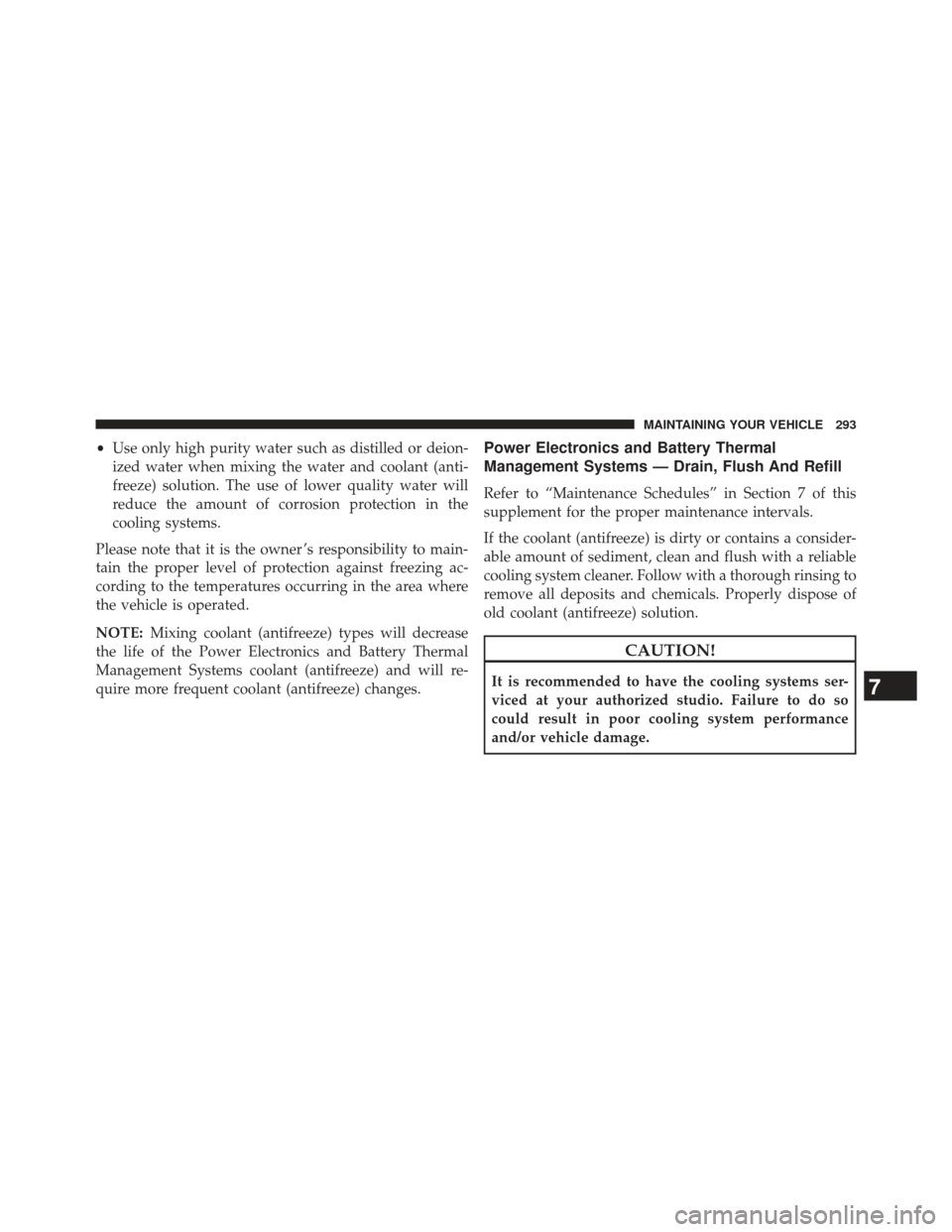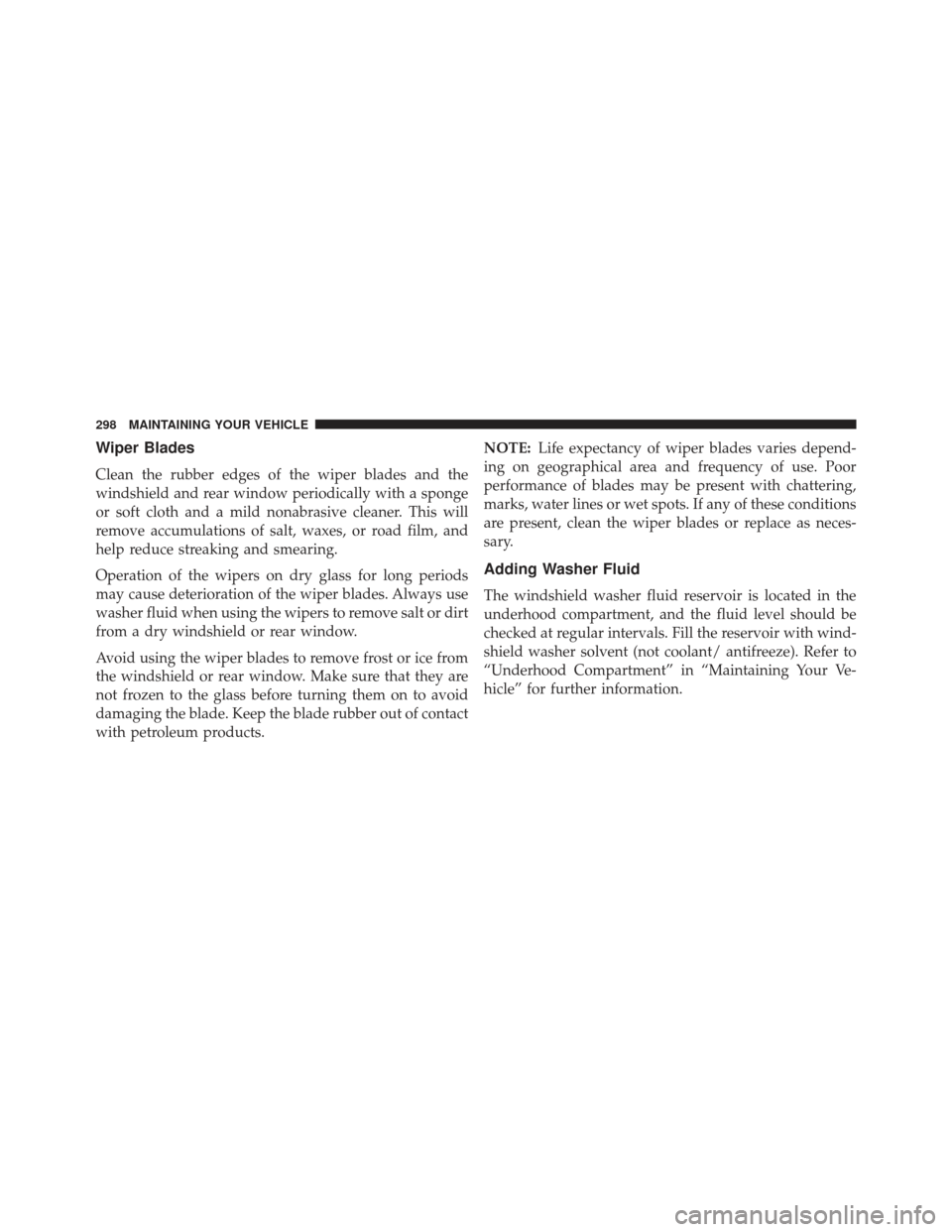Page 295 of 350

•Use only high purity water such as distilled or deion-
ized water when mixing the water and coolant (anti-
freeze) solution. The use of lower quality water will
reduce the amount of corrosion protection in the
cooling systems.
Please note that it is the owner ’s responsibility to main-
tain the proper level of protection against freezing ac-
cording to the temperatures occurring in the area where
the vehicle is operated.
NOTE: Mixing coolant (antifreeze) types will decrease
the life of the Power Electronics and Battery Thermal
Management Systems coolant (antifreeze) and will re-
quire more frequent coolant (antifreeze) changes.Power Electronics and Battery Thermal
Management Systems — Drain, Flush And Refill
Refer to “Maintenance Schedules” in Section 7 of this
supplement for the proper maintenance intervals.
If the coolant (antifreeze) is dirty or contains a consider-
able amount of sediment, clean and flush with a reliable
cooling system cleaner. Follow with a thorough rinsing to
remove all deposits and chemicals. Properly dispose of
old coolant (antifreeze) solution.
CAUTION!
It is recommended to have the cooling systems ser-
viced at your authorized studio. Failure to do so
could result in poor cooling system performance
and/or vehicle damage.7
MAINTAINING YOUR VEHICLE 293
Page 296 of 350

Disposal Of Used Power Electronics and Battery
Thermal Management Systems Coolant
Used antifreeze is a regulated substance requiring proper
disposal. Check with your local authorities to determine
the disposal rules for your community. To prevent inges-
tion by animals or children, do not store antifreeze in
open containers or allow it to remain in puddles on the
ground. If ingested by a child, contact a physician
immediately. Clean up any ground spills immediately.
Points To Remember
If an examination of your underhood compartment
shows no evidence of cooler or hose leaks, the vehicle
may be safely driven.
•Do not overfill the coolant recovery bottles. •
Check coolant (antifreeze) freeze point in the coolant
recovery bottles. If coolant (antifreeze) needs to be
added, contents of coolant recovery bottles must also
be protected against freezing.
• If frequent coolant (antifreeze) additions are required,
or if the level in the coolant recovery bottles does not
drop when the engine cools, the cooling system should
be pressure tested for leaks.
• Maintain coolant (antifreeze) concentration at 50%
OAT coolant (antifreeze) (minimum) and distilled/
deionized water for proper corrosion protection of
your engine which contains aluminum components.
• Make sure that the coolant control systems recovery
bottles overflow hoses are not kinked or obstructed.
• Keep the front of the coolant control systems clean. If
your vehicle is equipped with air conditioning, keep
the front of the condenser clean.
294 MAINTAINING YOUR VEHICLE
Page 300 of 350

Wiper Blades
Clean the rubber edges of the wiper blades and the
windshield and rear window periodically with a sponge
or soft cloth and a mild nonabrasive cleaner. This will
remove accumulations of salt, waxes, or road film, and
help reduce streaking and smearing.
Operation of the wipers on dry glass for long periods
may cause deterioration of the wiper blades. Always use
washer fluid when using the wipers to remove salt or dirt
from a dry windshield or rear window.
Avoid using the wiper blades to remove frost or ice from
the windshield or rear window. Make sure that they are
not frozen to the glass before turning them on to avoid
damaging the blade. Keep the blade rubber out of contact
with petroleum products.NOTE:
Life expectancy of wiper blades varies depend-
ing on geographical area and frequency of use. Poor
performance of blades may be present with chattering,
marks, water lines or wet spots. If any of these conditions
are present, clean the wiper blades or replace as neces-
sary.
Adding Washer Fluid
The windshield washer fluid reservoir is located in the
underhood compartment, and the fluid level should be
checked at regular intervals. Fill the reservoir with wind-
shield washer solvent (not coolant/ antifreeze). Refer to
“Underhood Compartment” in “Maintaining Your Ve-
hicle” for further information.
298 MAINTAINING YOUR VEHICLE
Page 316 of 350
FPT2010 Amp
Red Electronic Vehicle
Control Unit
(EVCU)
Cavity
Cartridge Fuse Description
FPT3 25 Amp Clear Batt Coolant
Pump
FPT5 20 Amp Yellow Inverter Coolant
Pump
VEHICLE STORAGE
The preferred way of storing your vehicle for a long
period of time is to leave it attached to a Level 1 or Level
2 charger. The vehicle has a wake-up feature that will
wake the system every 3 weeks and do a maintenance
charge on the 12 Volt battery and also top off the high
voltage battery if necessary. Anytime you store your vehicle, or keep it out of service
(i.e., vacation) for two weeks or more, run the air
conditioning system at idle for about five minutes in the
fresh air and high blower setting. This will ensure
adequate system lubrication to minimize the possibility
of compressor damage when the air conditioning system
is started again.
REPLACEMENT BULBS
Interior Bulbs
Bulb Number
Overhead Lamp C5W
Courtesy Lamp W5W
314 MAINTAINING YOUR VEHICLE
Page 321 of 350
FLUIDS, LUBES, AND GENUINE PARTS
ComponentFluid, Lubricant, or Genuine Part
Coolant MOPAR® Antifreeze/Coolant 10 Year/150,000 Mile
Formula OAT (Organic Additive Technology) or
equivalent meeting the requirements of Chrysler Ma- terial Standard MS-12106.
Brake Master Cylinder MOPAR® DOT 3, SAE J1703 should be used. If DOT
3, SAE J1703 brake fluid is not available, then DOT 4 is acceptable. Use only recommended brake fluids or equivalent.
Refrigerant MOPAR® R134a
Compressor Lubricant MOPAR® POE Oil or Equivalent meeting the require-
ments of Chrysler Material Standard MS-12727
Single-Speed Transmission Castrol BOT 533
7
MAINTAINING YOUR VEHICLE 319
Page 324 of 350
MAINTENANCE SCHEDULE
Once A Month Or Before A Trip:
•Check windshield washer fluid level
• Check the tire inflation pressures and look for unusual
wear or damage
• Check the fluid levels of the coolant reservoirs and
brake master cylinder
• Check function of all interior and exterior lights
Required Maintenance Intervals.
Refer to the maintenance schedules on the following
page for the required maintenance intervals.
At Every Service Interval:
• Rotate the tires. Rotate at the first sign of irregu-
lar wear.
• Inspect brake pads, shoes, rotors, drums, and
hoses.
• Inspect battery cooling system protection and
hoses.
• Check and adjust hand brake.
Maintenance Chart
Refer to the Maintenance Schedules on the following
pages for the required maintenance intervals.
8
M A I
N T
E
N
A
N
C E
S
C
H E
D
U L
E
S322 MAINTENANCE SCHEDULES